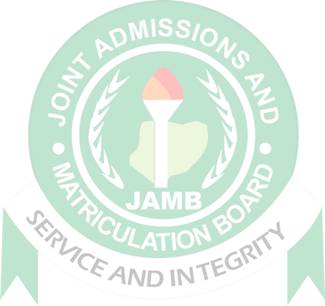
Chemistry
Paper 1 | Objectives | 50 Questions
JAMB Exam
Year: 2009
Level: SHS
Time:
Type: Question Paper
Answers provided
FREE
No description provided
Feedbacks
This paper is yet to be rated

Paper 1 | Objectives | 50 Questions
JAMB Exam
Year: 2009
Level: SHS
Time:
Type: Question Paper
Answers provided
No description provided
This paper is yet to be rated
Five revision strategies that are strange but effective for memorization for high exams performance
Effective ways of coping with exam stress and test anxiety which is supported by Science
12 Most Effective Ways to Pass Any Exams Without Studying Hard even when you don't have enough time.
| # | Question | Ans |
|---|---|---|
| 1. |
A mixture of sugar and sulphur can be separated by? A. dissolution in water, evapouration and filtration B. filtration, evaporation and dissolution in water C. dissolution in water, filtration and evaporation D. evaporation, dissolution in water and filtration
Show Content
Detailed SolutionSulfur is insoluble in water but sugar is soluble.Hence; dissolution of sugar to have sulfur as the only insoluble solid. Filtration: The filtrate is the liquid that passes through the filtration filter. Meanwhile, the residue is the solid that remains on the filtration filter. Evaporation: water as part of the filtrate changes into a gas to leave sugar as residue. There is an explanation video available below. |
|
| 2. |
Which of the following is a physical change? A. Freezing ice cream B. dissolving calcium in water C. burning kerosene D. Exposing white phosphorus to air
Show Content
Detailed SolutionFreezing is a physical change. It involves a liquid changing states to a solid. Thus, freezing a substance will not change its chemical identity, but its state.There is an explanation video available below. |
|
| 3. |
The percentage of water of crystallization in ZnSO\(_4\).7H\(_2\)O is? A. 33% B. 44% C. 55% D. 87%
Show Content
Detailed Solutionmolar mass of water [7H\(_2\)O] = 7[ 2 * 1 + 16] → 7 * 18 = 126g/molmolar mass of ZnSO\(_4\).7H\(_2\)O = [65 * 1] + [32 * 1] + [16 * 4] + 7[ 2 * 1 + 16] → 65 + 32 + 64 + 126 = 287g/mol percentage of water of crystallization = \(\frac{mass of water of crystallization}{mass of hydrated compound} * 100%\) → \(\frac{126}{287} * 100\) = 43.9 ≈ 44% There is an explanation video available below. |
|
| 4. |
0.0075 mole of calcium trioxocarbonate (IV) is added to 0.015 mole of a solution of hydrochloric acid. The volume of gas evolved at s.t.p is? A. 224cm3 B. 168cm3 C. 112cm3 D. 100cm3
Show Content
Detailed Solution1mole of gas at STP = 22.4dm\(^3\)0.0075 mole of CaCO3 = xdm\(^3\) cross multiply; where 22.4dm\(^3\) = 22400cm\(^3\) x * 1 = 0.0075 * 22400 → 168cm\(^3\) the gas CO2 which evolved was gotten from CaCO3 so we use the number of moles of CaCO3 only There is an explanation video available below. |
|
| 5. |
A gas exerts pressure on its container because? A. the molecules of a gas collide with the walls of the container B. some of the molecules are moving faster than others C. of the collisions of the molecules with each other D. of the mass of the molecules of the gas
Show Content
Detailed SolutionGas pressure is the name given to the force exerted by gas particles colliding with the wall of their container.There is an explanation video available below. |
|
| 6. |
The basic assumption in the kinetic theory of gases that the collisions of the gaseous molecules are perfectly elastic implies that the? A. forces of attraction and repulsion are in equilibrium B. gaseous molecules can occupy any available space C. gaseous molecules will continue their motion indefinitely D. gases can be compressed
Show Content
Detailed SolutionAn elastic collision is an encounter between two bodies in which the total kinetic energy of the two bodies remains the same.There is an explanation video available below. |
|
| 7. |
If an atom is represented as \( _{11}^{23}X \), which of the following deduction is correct? A. it contains 12 protons B. it forms a covalent chloride C. its atomic number is 23 D. it is an alkali metal
Show Content
Detailed SolutionSodium has atomic / proton number of 11 and belongs to Group 1[alkali metals] on the periodic tableThere is an explanation video available below. |
|
| 8. |
Cathode rays causes an object placed behind a perforated anode to cast a shadow on the screen. This observation shows that the rays? A. are positively charged B. are negatively charged C. have mass D. travel in straight lines
Show Content
Detailed SolutionCathode rays travel in a straight line and can cast sharp shadows.Cathode rays are negatively charged. Electric field and magnetic field deflect cathode rays. There is an explanation video available below. |
|
| 9. |
Which quantum number divides shells into orbitals? A. principal B. Arzimuthal C. Magnetic D. Spin
Show Content
Detailed SolutionThe principal quantum number, n, describes the energy of an electron and the most probable distance of the electron from the nucleus.In other words, it refers to the size of the orbital and the energy level an electron is placed in. The azimuthal quantum number is a quantum number for an atomic orbital that determines its orbital angular momentum and describes the shape of the orbital. There is an explanation video available below. |
|
| 10. |
The type of bonding in \({Cu(NH_3)_4}^2\)+ is? A. coordinate covalent B. electrovalent C. metallic D. covalent
Show Content
Detailed Solution\({Cu(NH_3)_4}^2\)+: The bonding in this ion consists of coordinate covalent bonds with all bonding electrons supplied by the nitrogen atom.There is an explanation video available below. |
Preview displays only 10 out of the 50 Questions